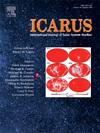The Martian oxygen green line dayglow: response to solar activity
IF 2.5
2区 物理与天体物理
Q2 ASTRONOMY & ASTROPHYSICS
引用次数: 0
Abstract
The Ultraviolet and Visible Spectrometer (UVIS) instrument of the Nadir and Occultation for MArs Discovery (NOMAD) aboard the ExoMars Trace Gas Orbiter (TGO) observes the Martian dayglow at 557.7 nm, which corresponds to the oxygen green line emission. Soret et al. (2022) analyzed a full Martian year of dayside limb observations and implied that some variability could be observed in both the altitude and intensity of the green dayglow. In this work, we take advantage of three Martian years of observations to analyze the evolution of the peak brightness and peak altitude of the oxygen green line emission during a period of increasing solar activity. We show that the limb brightness can change by ∼70 % from one Martian year to the other. The green line brightness is highly correlated with both seasonal and solar activity effects. The brightest intensities of the oxygen green line occur near perihelion and when solar insolation is highest. However, we observe that the peak altitude is highly correlated with season (maximum at perihelion) but it does not show a dependence on solar activity. Finally, we compare the evolution of the green line peak altitude with that of the 0.39-μbar pressure level provided by the Mars Climate Database (MCD) v6.1 and show that the calculated CO2 density can be overestimated by up to a factor of 2, especially in the northern hemisphere. We conclude that dayside observations of the green line emission are a powerful tool to constrain global circulation models and remotely monitor the dynamics of the Mars atmosphere over time and season in the 70–100 km region.
火星氧绿线的日光:对太阳活动的反应
ExoMars痕量气体轨道器(TGO)上搭载的火星探测探测卫星(NOMAD)的紫外可见光谱仪(UVIS)观测到火星上557.7 nm的日光,对应于氧的绿线发射。Soret等人(2022)分析了整个火星年的日侧翼观测结果,并暗示在绿色日光的高度和强度上都可以观察到一些变化。在这项工作中,我们利用三个火星年的观测,分析了在太阳活动增加期间氧绿线发射的峰值亮度和峰值高度的演变。我们发现,从一个火星年到另一个火星年,边缘亮度可以变化约70%。绿线亮度与季节和太阳活动的影响高度相关。最亮的氧绿线出现在近日点附近和太阳日照最高的时候。然而,我们观察到高峰高度与季节高度相关(在近日点最大),但它不依赖于太阳活动。最后,我们将绿线峰值高度的演变与火星气候数据库(MCD) v6.1提供的0.39 μbar压力水平的演变进行了比较,结果表明计算的CO2密度可被高估2倍,特别是在北半球。我们的结论是,对绿线发射的白天观测是约束全球环流模型和远程监测火星大气随时间和季节变化在70-100公里区域的有力工具。
本文章由计算机程序翻译,如有差异,请以英文原文为准。
求助全文
约1分钟内获得全文
求助全文
来源期刊

Icarus
地学天文-天文与天体物理
CiteScore
6.30
自引率
18.80%
发文量
356
审稿时长
2-4 weeks
期刊介绍:
Icarus is devoted to the publication of original contributions in the field of Solar System studies. Manuscripts reporting the results of new research - observational, experimental, or theoretical - concerning the astronomy, geology, meteorology, physics, chemistry, biology, and other scientific aspects of our Solar System or extrasolar systems are welcome. The journal generally does not publish papers devoted exclusively to the Sun, the Earth, celestial mechanics, meteoritics, or astrophysics. Icarus does not publish papers that provide "improved" versions of Bode''s law, or other numerical relations, without a sound physical basis. Icarus does not publish meeting announcements or general notices. Reviews, historical papers, and manuscripts describing spacecraft instrumentation may be considered, but only with prior approval of the editor. An entire issue of the journal is occasionally devoted to a single subject, usually arising from a conference on the same topic. The language of publication is English. American or British usage is accepted, but not a mixture of these.
 求助内容:
求助内容: 应助结果提醒方式:
应助结果提醒方式:


